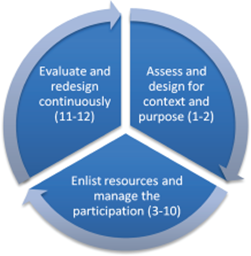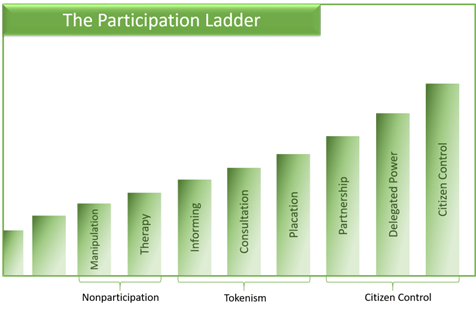TOPIC 4.5: Designing a participation process
Consultation is a cornerstone of developing public policy and has become a very familiar part of the public servant’s environment. Consultation needs to be understood in the context of its place in the continuum of relations between government and citizens, clients and stakeholders.
It is important that consultation processes are ‘fit for purpose’ and that methods of consultation or engagement match the intent, motive or policy development purpose.
In Module 2, we referred to the IAP2 public participation spectrum, which has been developed by the International Association for Public Participation. The spectrum is a useful guide as to diverse ways to engage stakeholders.
Bryson et al (2013)[1] affirm the importance of designing participation processes that are context, purpose and participant specific. They offer the following Design Guidelines for Public Participation:
Assess and design for context and purpose
- Assess and fit the design to the context and the problem.
- Identify purposes and design to achieve them.
Enlist resources and manage the participation
- Analyse and appropriately involve stakeholders.
- Work with stakeholders to establish the legitimacy of the process.
- Foster effective leadership.
- Seek resources for and through participation.
- Create appropriate rules and structures to guide the process.
- Use inclusive processes to engage diversity productively.
- Manage power dynamics
- Use technologies of various kinds to achieve participation purposes.
Evaluate and redesign continuously
- Develop and use evaluation measures.
- Design and redesign.
Note: These are interrelated, iterative tasks, not a step-by-step template.

Figure 4.1: The Cycle of Public Participation Process Design and redesign (Numbers indicate the corresponding design guidelines). Source: Bryson, J. et. al. (2013), p. 24
The spectrum of participant involvement in government decision-making may also be referred to as the ‘ladder’ of participation:
- Empower – shared decision-making.
- Collaborate – negotiated options and preferences.
- Involve – issues generation, ideas exploration.
- Consult – 2-way communication.
- Inform – 1- way communication.

Adapted from Lauria M & Slotterback, C. (2020).[2]
There are different forms of public engagement and we can differentiate between models of participation according to a public participation spectrum.
We distinguish between communication, consultation and co-production in terms of the extent of participant involvement in public decision-making:
Communication – one-way flow of information from service providers to the public for purposes of educating, updating creating awareness.
Consultation – two-way dialogue between service providers and the public.
Agencies may present a number of options to communities for preference selection, people may be given the opportunity to shape policy and even play a role in conducting consultation.
Typically, however, the service provider remains in control of this phase. This activity recognises a need for some level of authority to be exercised in the participation process to ensure action actually occurs or to provide a level of arbitration in the event of irreconcilable views or disputes within the community.
Co-production – active involvement of the public in policy decisions and/ or service design and delivery. This activity relies on the participation of communities and individuals in order to match provider performance with user requirements and response. It embraces the notion that the input of communities can and should be tapped into for innovation and in order to increase the chance of the service meeting user needs. Communities are viewed not as passive participants but as actors empowered to take greater control over, and responsibility for, their lives.
As you saw in Module 3, Appreciative Inquiry is one method to engage people and to facilitate co-production and co-design in the policy development process.
25 min
Read this excellent chapter on innovative ways of engaging citizens in co-creation of policy and co-design of services in the following handbook:
It follows that there are different avenues available for pursuing participation. There are also some realistic obstacles such as apathy, lack of awareness and education, the presence of irreconcilable differences and so on. Be clear in designing a consultation process to match your method with your motive (to avoid mixed messages, unrealistic expectations, unwilling participants and potential distrust).
Implementing consultation through deliberative processes involves building a new kind of relationship between the decision-maker and the stakeholders: consultation is not ad hoc but integral to the process. Effective consultation is a planned and timely activity, which enables participants to engage in debate, discussion and negotiation.
Recommended
60 mins
Activity
In South Australia the contentious issue of what strategy to adopt with nuclear waste was put to a citizen jury with interesting results.
Research and discuss Citizen Jury examples:
- Why a citizen jury?
- Effectiveness of process design and delivery?
- Outcome for stakeholders? Lessons learnt?
- …….and more recently a citizen jury in Alice Springs regarding amendment to the Constitution?
Reflection
Think about examples of public consultation undertaken by your agency.
- What rung is your agency currently operating at?
What are the pros and cons of deliberative polling? i.e. where government may design online survey instruments to engage citizens in decision choices around difficult questions such as asset sales, health expenditure, debt reduction etc.
- Is this community engagement approach a new form of e-democracy?
- What are the strengths and limitations of the deliberative polling approach?
- Bryson, J. M., Quick, K. S., Slotterback, C. S., & B. C. Crosby, B. C. (2013). Designing Public Participation Processes. Public Administration Review 73(1): 23-34. ↵
- Lauria, M., & Slotterback, C.S. (2020). Learning from Arnstein’s Ladder: From Citizen Participation to Public Engagement (1st ed.). Routledge. ↵

